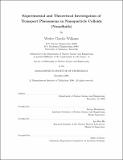Experimental and theoretical investigation of transport phenomena in nanoparticle colloids (nanofluids)
Author(s)
Williams, Wesley Charles, 1976-
DownloadFull printable version (6.580Mb)
Other Contributors
Massachusetts Institute of Technology. Dept. of Nuclear Science and Engineering.
Advisor
Jacopo Buongiorno and Lin-Wen Hu.
Terms of use
Metadata
Show full item recordAbstract
This study investigates the thermal transport behavior of nanoparticle colloids or nanofluids. The major efforts are: to determine methods to characterize a nanoparticle colloid's mass loading, chemical constituents, particle size, and pH; to determine temperature and loading dependent viscosity and thermal conductivity; to determine convective heat transfer coefficient and viscous pressure losses in an isothermal and heated horizontal tube; and finally to determine the feasibility for potential use as enhanced coolants in energy transport systems, with focus on nuclear application. The efforts result in proving that the two selected nanofluids, alumina in water and zirconia in water, have behavior that can be predicted by existing single phase convective heat transfer coefficient and viscous pressure loss correlations from the literature. The main consideration is that these models must use the measured mixture thermophysical properties. With the acquired knowledge of the experiments, investigation into the potential use or optimization of a nanofluid as an enhanced coolant is further explored. The ultimate goal of contributing to the understanding of the mechanisms of nanoparticle colloid behavior, as well as, to broaden the experimental database of these new heat transfer media is fulfilled.
Description
This electronic version was submitted by the student author. The certified thesis is available in the Institute Archives and Special Collections. Thesis (Ph. D.)--Massachusetts Institute of Technology, Dept. of Nuclear Science and Engineering, 2007. Includes bibliographical references (p. 245-255).
Date issued
2007Department
Massachusetts Institute of Technology. Department of Nuclear Science and EngineeringPublisher
Massachusetts Institute of Technology
Keywords
Nuclear Science and Engineering.